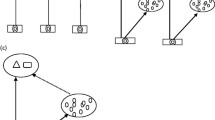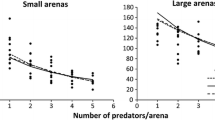Abstract
We examined the effects of intraguild predation (IGP) and interference competition on an endangered dragonfly, Aeshna viridis Eversm. (Odonata: Anisoptera). A. viridis is rare in Europe due to the decrease in suitable habitats harboring the macrophyte Stratiotes aloides L. Stratiotes plants are the principal oviposition substrate for A. viridis females and protect the larvae of A. viridis from fish predation. In our study lakes A. viridis larvae are sympatric with larvae of Aeshna grandis and Aeshna juncea. The susceptibility of A. viridis larvae to IGP by similar-sized larvae of A. grandis and A. juncea was tested in a laboratory predation experiment. Microhabitat use of A. viridis and A. grandis was studied in the laboratory to determine the possible effects of interference competition on the spatial distribution of A. viridis larvae. Our results show that at least in laboratory conditions, A. viridis is susceptible to IGP and interference competition. In competition, A. grandis larvae dominated the middle and outer portion of S. aloides rosettes whereas A. viridis stayed in the inner parts. When A. grandis larvae were absent, A. viridis colonized the middle and outer parts of the rosettes. We conclude that asymmetric predation between odonate larvae of equal size can be intense, and that both IGP and interference competition affect A. viridis. Although natural habitat complexity diminishes their impact, these interactions may nevertheless influence the distribution of A. viridis in S. aloides waters and restrict its microhabitat use in S. aloides rosettes.

Similar content being viewed by others
References
Anholt BR (1990) An experimental separation of interference and exploitative competition in a larval damselfly. Ecology 71:1483–1493
Askew RR (1988) The dragonflies of Europe. Harley Books, Martins
Benke AC (1978) Interactions among co-existing predators–a field experiment with dragonfly larvae. J Anim Ecol 47:335–350
Corbet PS (1999) Dragonflies: behavior and ecology of odonata. Harley Books, Martins
Crowley PH, Dillon PM, Johnson DM, Watson CN (1987) Intraspecific interference among larvae in a semivoltine dragonfly population. Oecologia 71:447–456
Fincke OM (1994) Population regulation of a tropical damselfly in the larval stage by food limitation, cannibalism, intraguild predation and habitat drying. Oecologia 100:118–127
Gibbons B (1986) Dragonflies and damselflies of Britain and Northern Europe. Hamlyn, London
Heidemann H, Seidenbusch R (1993) Die Libellenlarven Deutschlands und Frankreichs. Handbuch für Exuviensammler. Bauer, Keltern
Henrikson B-I (1988) The absence of antipredator behaviour in the larvae of Leucorrhinia dubia (Odonata) and the consequences for their distribution. Oikos 51:179–183
Holt RD, Polis GA (1997) A theoretical framework for intraguild predation. Am Nat 149:745–764
Hopper KR, Crowley PH, Kielman D (1996) Density dependence, hatching synchrony, and within-cohort cannibalism in young dragonfly larvae. Ecology 77:191–200
Johansson F (1993) Intraguild predation and cannibalism in odonate larvae: Effects of foraging behaviour and zooplankton availability. Oikos 66:80–87
Johnson DM (1991) Behavioral ecology of larval dragonflies and damselflies. Trends Ecol Evol 6:8–13
Johnson DM, Crowley PH, Bohanan RE, Watson CN, Martin TH (1985) Competition among larval dragonflies: a field enclosure experiment. Ecology 66:119–128
Koperski P (2002) Factors determining diversity in diet composition: multivariate analysis of a guild of epiphytic predators. Arch Hydrobiol 155:291–314
McPeek MA (1990a) Determination of species composition in the Enallagma damselfly assemblages of permanent lakes. Ecology 71:83–98
McPeek MA (1990b) Behavioral differences between Enallagma species (Odonata) influencing differential vulnerability to predators. Ecology 71:1714–1726
Münchberg P (1930) Zur Biologie der Odonatengenera Brachytron Evans und Aeschna Fbr. Z Morphol Ökol Tiere 20:172–232
Pierce CL (1988) Predator avoidance, microhabitat shift, and risk-sensitive foraging in larval dragonflies. Oecologia 77:81–90
Pierce CL, Crowley PH, Johnson DM (1985) Behavior and ecological interactions of larval Odonata. Ecology 66:1504–1512
Polis GA, Myers CA, Holt RD (1989) The ecology and evolution of intraguild predation: Potential competitors that eat each other. Annu Rev Ecol Syst 20:297–330
Rantala MJ, Ilmonen J, Koskimäki J, Suhonen J, Tynkkynen K (2004) The macrophyte, Stratiotes aloides, protects larvae of dragonfly Aeshna viridis against fish predation. Aquat Ecol 38:77–82
Rantalainen E, Kanervo E (1928) Aeschna viridiksen esiintymisestä ja elintavoista Suomessa. Luonnon Ystävä 32:161–170
Rassi P, Alanen A, Kanerva T, Mannerkoski I (2001) Threatened species in Finland in 2001. Ministry of the Environment and Finnish Environment Institute, Helsinki
Schmidt EB (1975) Aeshna viridis Eversmann in Schleswig-Holstein, Bundesrepublik Deutschland (Anisoptera: Aeshnidae). Odonatologica 4:81–88
Smolders AJP, Roelofs JGM, Den Hartog C (1996) Possible causes for the decline of the water soldier (Stratiotes aloides L.) in the Netherlands. Arch Hydrobiol 136:327–342
Stoks R, McPeek MA, Mitchell JL (2003) Evolution of prey behavior in response to changes in predation regime: damselflies in fish and dragonfly lakes. Evolution 57:574–585
Suhling F (2001) Intraguild predation, activity patterns, growth and longitudinal distribution in running water odonate larvae. Arch Hydrobiol 151:1–15
Valle KJ (1952) Suomen eläimet 7. Sudenkorennot. WSOY, Turku
Valtonen P (1997) Suku Aeshna Suomessa ja Pirkanmaalla. 1. osa. Diamina 6:6–12
Van Buskirk J (1989) Density-dependent cannibalism in larval dragonflies. Ecology 70:1442–1449
Van Buskirk J (1992) Competition, cannibalism, and size class dominance in a dragonfly. Oikos 65:455–464
Wellborn GA, Robinson JV (1987) Microhabitat selection as an antipredator strategy in the aquatic insect Pachydiplax longipennis Burmeister (Odonata: Libellulidae). Oecologia 71:185–189
Wissinger SA (1988) Effects of food availability on larval development and inter-instar predation among larvae of Libellula lydia and Libellula luctuosa (Odonata: Anisoptera). Can J Zool 66:543–549
Wissinger SA (1992) Niche overlap and potential for competition and intraguild predation between size-structured populations. Ecology 73:1431–1444
Acknowledgements
We thank the Regional Environmental Centers and Finnish Environment Institute for granting the licences needed to collect and study A. viridis. We also thank Katja Tynkkynen and Mari Luojumäki for assistance in the field, and the members of the Round Table and two anonymous referees for their constructive comments on the manuscript. The study was funded by the Ministry of the Environment (Finnish Biodiversity Programme, FIBRE), and supported by the Finnish Cultural Foundation (Häme), the Academy of Finland (to Jukka Suhonen) under the Finnish Centre of Excellence Programme during 2000–2005 (project 44878), Societas pro Fauna et Flora Fennica and Jenny and Antti Wihuri Fund (to E.S.).
Author information
Authors and Affiliations
Corresponding author
Rights and permissions
About this article
Cite this article
Suutari, E., Rantala, M.J., Salmela, J. et al. Intraguild predation and interference competition on the endangered dragonfly Aeshna viridis . Oecologia 140, 135–139 (2004). https://doi.org/10.1007/s00442-004-1559-6
Received:
Accepted:
Published:
Issue Date:
DOI: https://doi.org/10.1007/s00442-004-1559-6




